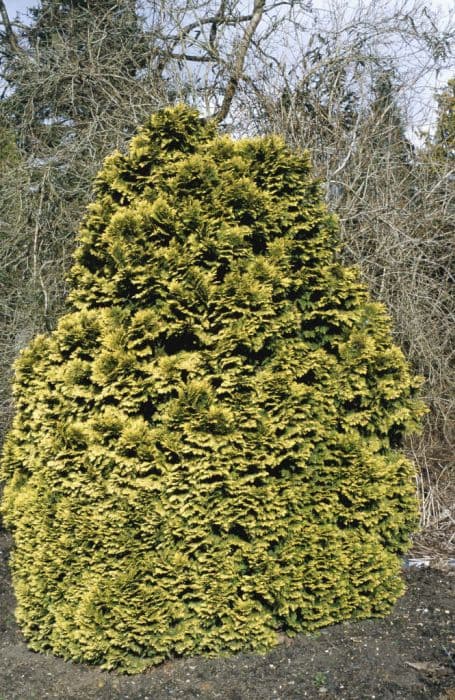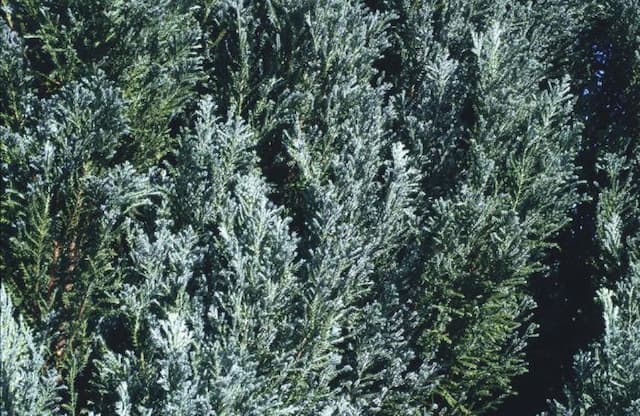Common Juniper Juniperus communis 'Repanda'

ABOUT
The Repanda Juniper is a low-growing, spreading evergreen shrub with arching branches that create a dense, mat-like form. Its foliage presents an attractive dark green color throughout the year, which tends to be needle-like when the plant is young but becomes more scale-like with maturity. During the colder months, the plant's tips may develop a slightly purplish hue, adding to its visual interest. Small yellow flowers may appear in the spring, although they are not particularly showy and sometimes go unnoticed. These flowers give way to small berries that transition from a green color when young to a dark, blue-black shade when ripe. These berries, often called cones, can be a point of interest on the plant, and they are frequently used in a variety of culinary and traditional practices. The overall shape of the Repanda Juniper is expansively horizontal, often making it a preferred choice for ground cover. It creates a lush, evergreen carpet that hugs the ground, and its soft texture can be a striking contrast to rough surfaces like rocks or garden paths. The foliage is dense enough to suppress weeds, providing a low-maintenance option for landscaping needs.
About this plant
 Names
NamesFamily
Cupressaceae.
Synonyms
Repanda Juniper, Common Juniper.
Common names
Juniperus communis 'Repanda'.
 Toxicity
ToxicityTo humans
Juniper Berry might not be considered highly toxic to humans when consumed in small, typical culinary quantities, such as those used for flavoring gin. However, when ingested in large amounts, it can be potentially harmful. The most notable toxicity concern is with the consumption of the immature, unripe berries, which can cause gastrointestinal issues and kidney damage. Symptoms of juniper berry poisoning may include stomach upset, diarrhea, and kidney irritation. Pregnant women should avoid consuming juniper berries as they may stimulate the uterus and potentially cause miscarriages.
To pets
Juniper Berry is also considered only slightly toxic to pets, but consumption of a significant quantity of this plant can lead to gastrointestinal upset in dogs and cats. Symptoms of poisoning in pets may include vomiting, diarrhea, and abdominal pain. Though not commonly fatal, ingestion of juniper plants should be avoided, and pets displaying signs of distress after consuming plant material should be examined by a veterinarian to manage any potential toxicity.
 Characteristics
CharacteristicsLife cycle
Perennials
Foliage type
Evergreen
Color of leaves
Green
Height
1 foot (0.3 meters)
Spread
6 feet (1.8 meters)
Plant type
Shrub
Hardiness zones
2-6
Native area
Europe
Benefits
 General Benefits
General Benefits- Low Maintenance: This variety of common juniper requires minimal care once established, making it a convenient choice for gardens and landscapes.
- Drought Tolerance: The plant is drought-resistant, saving water resources and adapting well to dry conditions.
- Erosion Control: The dense, spreading growth habit helps to stabilize soil and prevent erosion on slopes and banks.
- Habitat for Wildlife: It provides shelter and nesting sites for birds and other wildlife, enhancing biodiversity in the environment.
- Aesthetic Appeal: Its attractive, evergreen foliage adds year-round interest to garden settings, contributing to the overall beauty of the landscape.
- Cold Hardy: The plant is tolerant of cold temperatures, making it suitable for a variety of climates and able to withstand harsh winters.
- Low Growing Habit: With its ground-covering nature, it helps to suppress weeds and reduce the need for additional weed control methods.
- Versatile Landscaping: It can be used as a specimen plant, for mass planting, or in rock gardens, offering flexibility in landscape design.
- Deer Resistance: The plant is generally resistant to browsing by deer, which can be particularly beneficial in areas where deer predation is a problem.
 Medical Properties
Medical Properties- Diuretic: Juniper berries from the common juniper are traditionally used to promote urinary flow.
- Antiseptic: The essential oil of juniper has been used for its antiseptic properties.
- Carminative: Juniper can aid in the relief of flatulence and bloating.
- Antirheumatic: It has been employed to alleviate rheumatic pain.
- Antispasmodic: Juniper may help to reduce muscle spasms.
- Digestive aid: The plant is known to stimulate the appetite and improve digestion.
 Air-purifying Qualities
Air-purifying QualitiesThis plant is not specifically known for air purifying qualities.
 Other Uses
Other Uses- Flavoring alcohol: Juniper berries from the plant are used to impart a distinctive flavor to gin and other spirits.
- Insect repellant: The aromatic oils in the foliage can be used as a natural insect repellant when rubbed on the skin.
- Culinary seasoning: The dried berries are crushed and used as a spice in various dishes, particularly in European cuisine.
- Perfumery: The essential oils extracted from juniper are sometimes used in perfumes and fragrances for their crisp, fresh scent.
- Incense: Both the berries and the wood can be burned as incense, offering a cleansing and purifying aroma.
- Horticultural art: This particular cultivar, with its low spreading habit, is often used in bonsai and topiary for decorative purposes.
- Soil stabilization: 'Repanda' is effective in controlling soil erosion due to its dense mat-like growth.
- Craft material: The wood and branches can be used to make small craft items or even as a base for wreaths.
- Festive decoration: The plant's berries and boughs are commonly used to create holiday decorations, especially in wreaths and garlands.
- Wildlife habitat: Provides shelter and food for birds and other wildlife, particularly where ground cover is needed.
Interesting Facts
 Feng Shui
Feng ShuiThe Juniper is not used in Feng Shui practice.
 Zodiac Sign Compitability
Zodiac Sign CompitabilityThe Juniper is not used in astrology practice.
 Plant Symbolism
Plant Symbolism- Protection: Traditionally, junipers have been regarded as protective plants, often used to ward off evil spirits and negative energies. The dense and prickly foliage of 'Repanda' can be seen as forming a protective barrier.
- Purity: Juniper is also associated with purification and cleansing. Burning juniper branches was a way to purify the air and clear out unwanted presences, a symbolic trait linked to the plant’s antiseptic qualities.
- Healing: Given its use in various traditional medicines, juniper can symbolize healing and health. The 'Repanda' juniper variety, with its hardiness, may embody this meaning.
- Longevity and Endurance: Juniper plants are known for their longevity and resilience in the face of harsh conditions, traits that can be symbolically applied to their representation of endurance and the ability to thrive for long periods.
 Water
WaterCommon Juniper should be watered deeply rather than frequently, ensuring the soil is allowed to dry out between waterings. During the growing season, this typically means watering approximately once every week or two, giving the plant about 1-2 gallons of water each time, depending on the weather conditions and soil type. Young plants may need more frequent watering until they are established. It is crucial to avoid overwatering, as Juniper is prone to root rot in soggy soil.
 Light
LightThe Common Juniper thrives in full sun conditions, meaning it requires at least 6 hours of direct sunlight each day. It will do best in an open space where it can receive unfiltered sunlight throughout the day. Although it can tolerate partial shade, too little light can lead to sparse foliage and poor growth.
 Temperature
TemperatureCommon Juniper is quite hardy and can withstand a range of temperatures. It can survive in temperatures as low as -30 degrees Fahrenheit and as high as over 100 degrees Fahrenheit. However, the ideal temperature range for this plant is between 60 and 80 degrees Fahrenheit.
 Pruning
PruningPruning Common Juniper is essential to maintain its shape and promote healthy growth. The best time for pruning is in late winter or early spring before new growth starts. Prune sparingly, removing dead or damaged branches and shaping as desired. Pruning should be done annually for aesthetic purposes and to improve air circulation within the plant.
 Cleaning
CleaningNot needed
 Soil
SoilCommon Juniper 'Repanda' thrives in well-draining, sandy or loamy soil with a pH range of slightly acidic to neutral, approximately 6.0 to 7.0. A soil mix of one-third topsoil, one-third sand or perlite, and one-third peat or compost is ideal to support its root system and ensure adequate drainage.
 Repotting
RepottingCommon Juniper 'Repanda' is slow-growing and does not require frequent repotting; typically, repotting every 3 to 5 years is sufficient. It's important to repot in the early spring, just before the growing season begins, if the plant has outgrown its current container or the soil is exhausted.
 Humidity & Misting
Humidity & MistingCommon Juniper 'Repanda' prefers a dry to moderate humidity level and can tolerate the conditions found in most outdoor environments. It does not require high humidity and is quite resistant to drought once established.
 Suitable locations
Suitable locationsIndoor
Ensure bright light, cool temps and avoid overwatering.
Outdoor
Plant in sunny spot, well-drained soil, water sparingly.
Hardiness zone
2-6 USDA
 Life cycle
Life cycleCommon Juniper 'Repanda', like most conifers, starts its life cycle with seed germination, after which a seedling emerges and establishes itself. As it matures into a young plant, vegetative growth occurs with a spreading habit, producing dense foliage. Over several years, it reaches maturity and begins reproducing, forming unisexual cones; the female cones develop into fleshy and aromatic juniper berries while the male cones release pollen. Following pollination, the fertilized seeds develop within the berries. Once ripe, the berries can be dispersed by birds or other animals, facilitating the spread of seeds to new locations. The plant then continues to grow and can live for many years, repeating the reproductive cycle annually.
 Propogation
PropogationPropogation time
Late Winter-Early Spring
Juniperus communis 'Repanda', commonly known as the Common Juniper, is typically propagated through cuttings. This method is favored due to its simplicity and effectiveness. To propagate by cuttings, one would take semi-ripe cuttings of around 4 to 6 inches (10 to 15 centimeters) in length during the late summer. These cuttings should have a heel if possible, which means a small portion of the older wood at the base of the cutting. They are then inserted into a well-drained, sandy soil mix and kept under high humidity with bottom heat of about 70°F (around 21°C). It may take several months for the cuttings to root properly, so patience is necessary. After rooting, the new Junipers can be transplanted into individual pots to allow continued growth before eventually planting them in their permanent location.









